Figuring out what is wrong with your tree can feel impossible without some help. Have you started to notice your arborvitae tree turning brown and don't know what is causing it? Don't fret, we're here to help. For your convenience, we've brought you the answer to help solve your problem.
Your arborvitae tree might be dying for multiple reasons. Most often, arborvitae trees brown and die due to either over-saturated soil or extreme drop in temperature. Another potential reason for your tree dying could be due to not having enough sunlight. Each tree is different, but arborvitae generally doesn't do well in extremely cold or overly shaded environments.
As we begin, we will cover all things arborvitae and discuss how to save a dying tree. Whether you over-watered your tree, or the weather has been extreme, it is crucial to act fast to save your arborvitae. With that said, let's dive right into this topic!
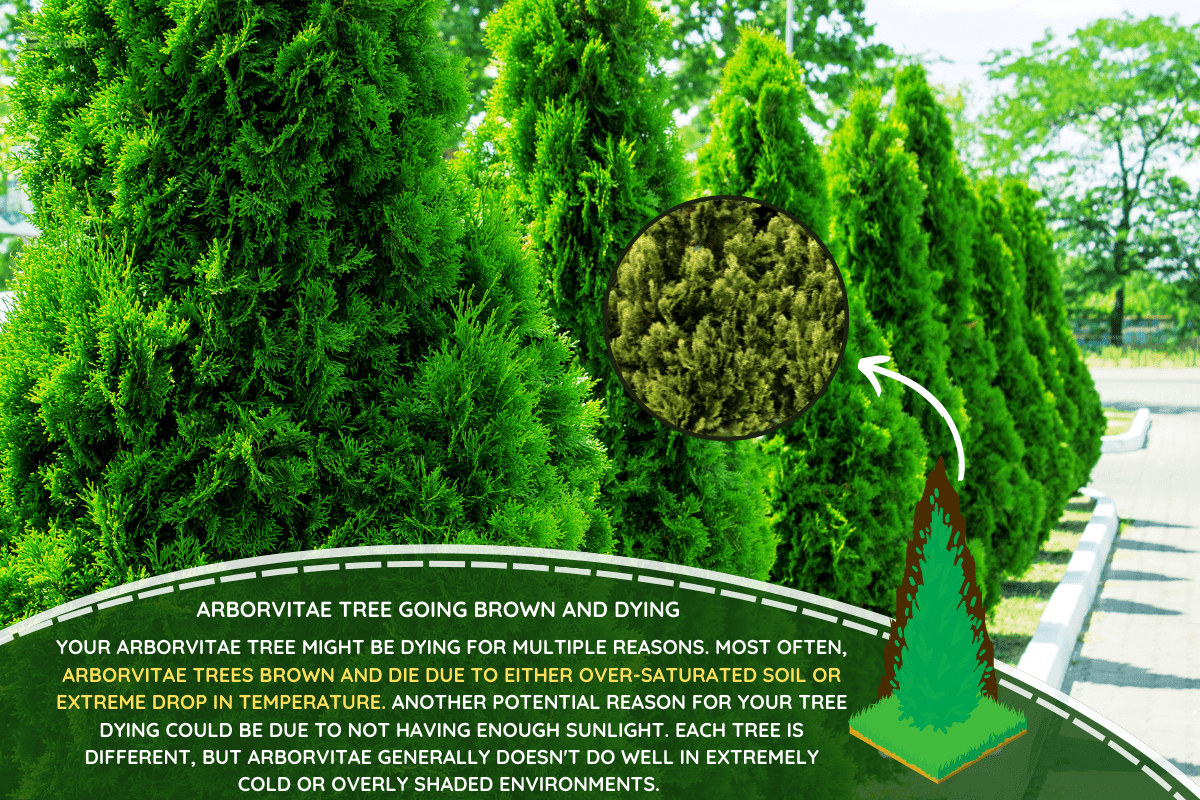
Can Brown Arborvitae Be Saved?
When it comes to saving brown arborvitae, time is of the essence. Usually, once your tree has turned brown, you have very little time to correct it.
We found that adding new mulch around the base of browning arborvitae will slow down the dying process and might save your tree altogether. Another way to save browning arborvitae is to prune your tree once it begins to show new growth in the springtime.

Preventing browning or deterioration is possible for wintertime, whether it means relocating your arborvitae or simply covering it. We've got more good tips on winter care, just ahead.
Here is a brown wood mulch from MIGHTY109 to add to your arborvitae tree's base. This mulch is 42 quarts and promises to help maintain soil temperature and prevent weed growth.
Check it out on Amazon by clicking here.
Should I Move My Arborvitae Inside During Winter?
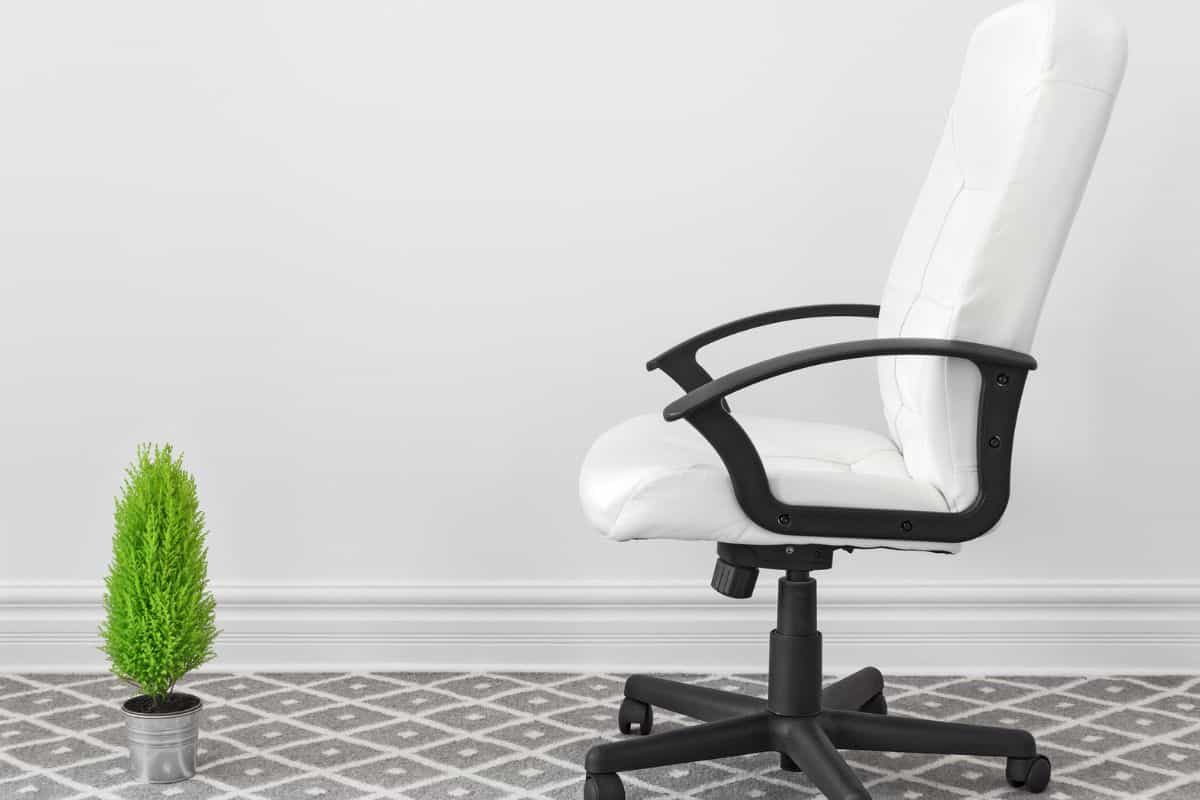
Depending on the weather where you live, moving an arborvitae tree inside might be a good option. If this is something you plan on doing, make sure to locate your tree somewhere with plenty of sunlight within your home. A good place for trees like arborvitae is near a bright window or an inside patio location.
We recommend moving your tree indoors around late fall to allow it some time to adjust to its new location before the temperature drops dramatically. If you cannot find a bright, warm spot for your tree, we suggest looking into an indoor plant light.
This light has four adjustable heads, ten brightness levels, three light modes, and stands up to 63 inches tall.
Follow this link to see it on Amazon.
What Causes An Arborvitae Tree To Brown?
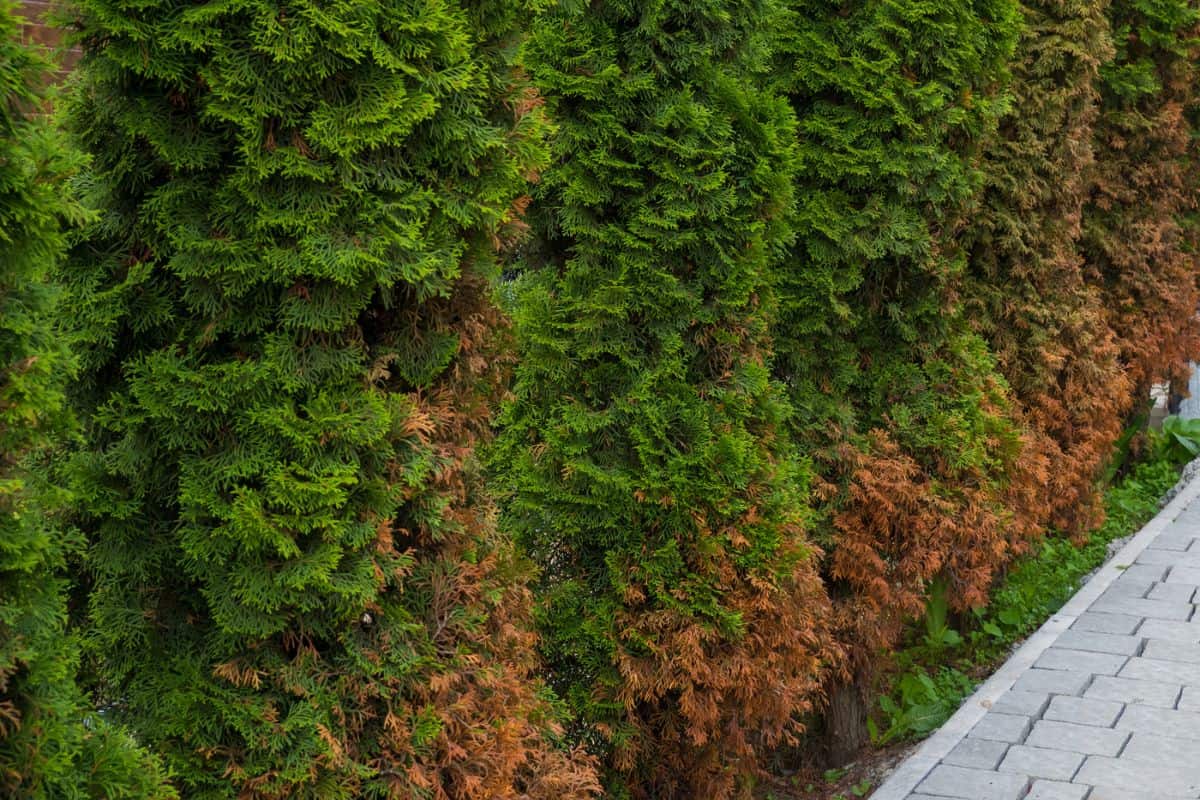
Typically, arborvitae trees begin to brown throughout the year due to many different reasons. Sudden temperature drops are one of the leading causes of browning arborvitae and are usually a sign of a dying tree. Freezing weather can often make its way into your tree's root system and essentially kill it from the ground up.
Another reason your arborvitae tree has turned brown could be due to drought or a lack of proper sunlight. Depending on the season, it is always important to check your arborvitae often and keep it protected and watered.
What Is Winter Burn?
Winter burn is when an evergreen tree, like arborvitae, is exposed to freezing weather and dies due to its roots becoming frozen. Although this happens to even the strongest trees, shallow or underdeveloped root systems are at high risk for winter burn if exposed to freezing temperatures.
According to the University of Wisconsin-Madison's Horticulture division, winter burn often goes unnoticed until the spring once the snow has melted off your tree. Generally, it is good to either cover arborvitae during a freeze or move it into a warmer climate until the weather improves.
This cover is UV stabilized spun polypropylene fabric, protects plants in up to negative eight degrees, and comes in various sizes.
Check this tree cover out on Amazon here.
Why Is My Newly Planted Arborvitae Turning Brown?
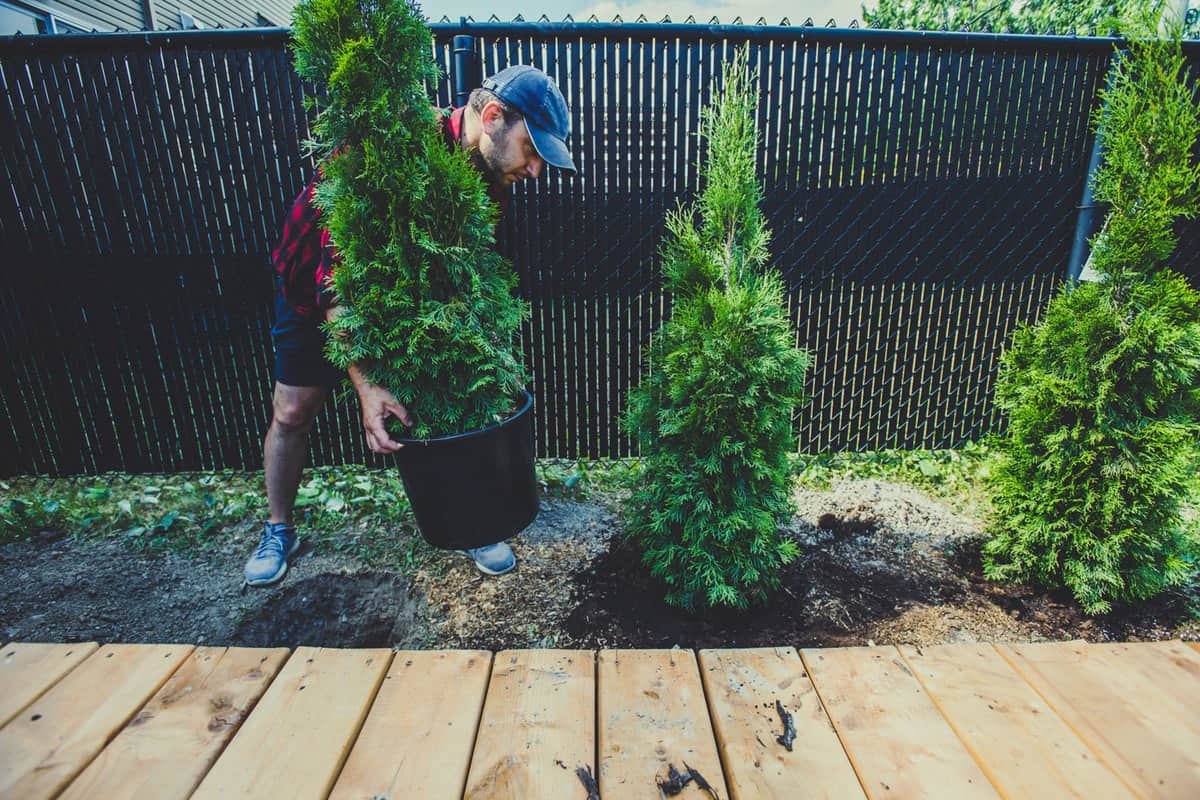
For those of you noticing your newly planted arborvitae turning brown, this is fairly common. When you relocate or replant arborvitae, you risk damaging its root system, causing your tree to turn brown. Although this is relatively common, depending on the root damage, this can be fatal to your tree. We recommend being very careful while removing or replanting your arborvitae tree and making sure you get all of its original roots.
How Much Should I Water A Newly Planted Arborvitae?
Generally, we suggest keeping a newly planted arborvitae moist for its first couple of weeks. With that said, you don't need to overwater your tree, so once per day is more than enough. Arborvitae, for the most part, are relatively low-maintenance trees and prefer moist, well-draining soil.
What Does Overwatered Arborvitae Look Like?
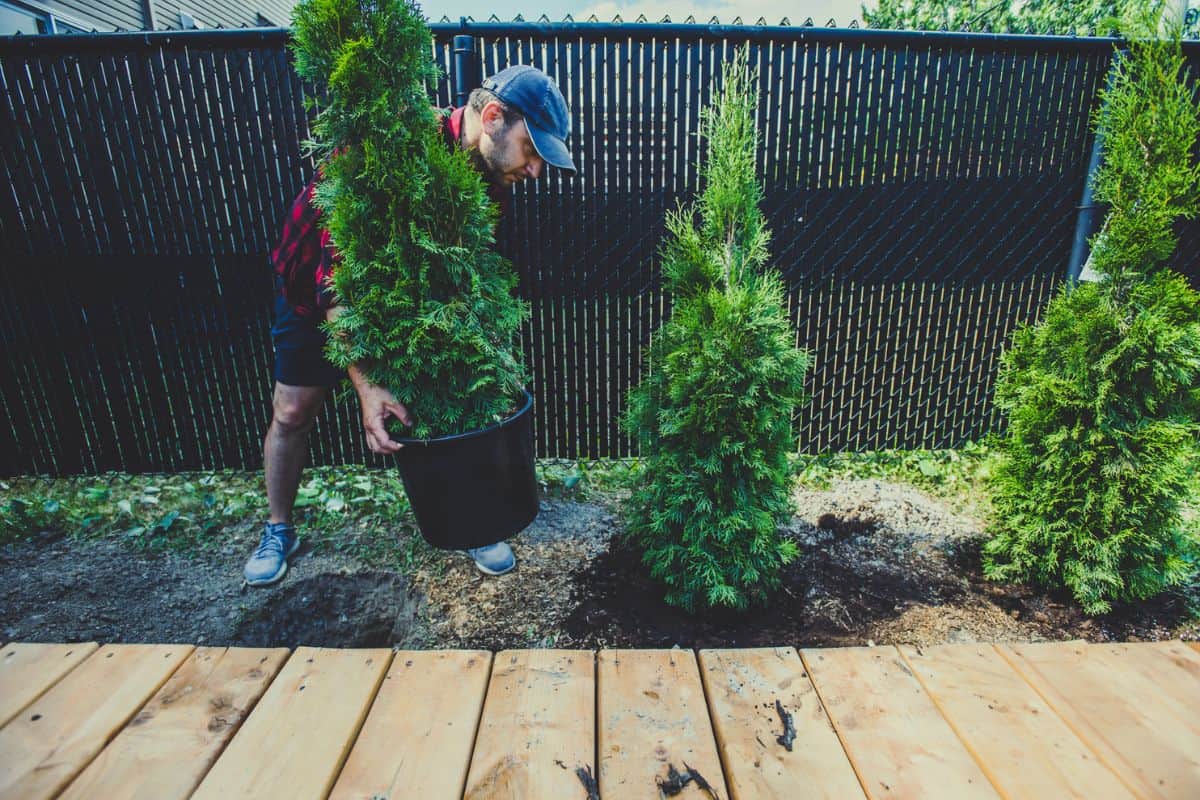
When it comes to an overwatered arborvitae tree, you should start to notice yellowing leaves. Most times, overwatered arborvitae will also begin to wobble in its soil, similar to a loose tooth. If you see your plant start to fall over or turn yellowish-brown, lay back on the water and try to let it dry out a bit. Luckily, this should not kill your tree and it will improve in a few weeks as long as you don't continue to overwater your arborvitae.
Here we have a self aerating and watering planter from HB Services for your arborvitae tree. This planter is one gallon, promotes healthy roots, and is BPA-free.
View this planter on Amazon by clicking here.
How Often Should I Water An Arborvitae Tree?
Once your arborvitae tree is acclimated, you should only need to water it every three to four days. Although every tree is different, a newly planted arborvitae should be fine to have less frequent watering after about four weeks. After about six weeks, this is when you should only water your tree once per week. Depending on the weather, you might need to increase or decrease your trees watering, so check its soil often.
This meter promises instant and accurate results, is easy to read, and comes in two sizes.
See this moisture meter on Amazon here.
Do Arborvitae Trees Like Full Sun?

Typically, arborvitae trees prefer full sun and moderate climate. Although this evergreen tree will grow in the shade, it does need around six hours of full sunlight per day. Climate-wise, arborvitae trees thrive in various temperatures, as long as freezing weather is not a regular occurrence. Usually, these trees grow in zones two through seven and are prevalent in the United States and Canada.
How Big Does An Arborvitae Get?

Generally, arborvitae trees reach heights between 40 and 60 feet and spread out 10 to 15 feet once fully mature. Arborvitae, in general, is perfect for creating barriers and grows at a moderate speed of about one to two feet per year. These beautiful trees are often found in luxury communities and are not too expensive if you buy them young.
Here we have a live potted arborvitae tree to plant in your garden. This tree comes fully rooted in a three-gallon container and can be planted as soon as it arrives.
To Wrap Things Up
Whether your arborvitae tree has turned entirely brown or is just starting to, fast action is essential. From what we found, laying down new mulch will help slow the dying process and, in turn, potentially save your tree. Regardless of where you live, make sure not to overwater your arborvitae and plant it somewhere with good natural sunlight.
Another way to save browning arborvitae is to wrap it with a warm cover to prevent further freezing. If you don't want to risk freezing temperatures, we suggest bringing your tree inside for the winter around the last week of fall.
Want to read more? Check out these helpful related plant reads!

19 Dwarf Evergreen Shrubs For Full Sun







Can u cut an opening in an arborvitae wall for a passage through ?
MY EMERALD GREEN ARBORVITAE ‘SMARAGD’ LOOKS GREEN ON THE OUTSIDE BUT THE INNER CORE IS BROWN. WHAT TO DO?